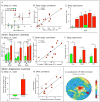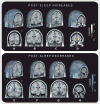Sleep-dependent memory consolidation and reconsolidation
- PMID: 17470412
- PMCID: PMC2680680
- DOI: 10.1016/j.sleep.2007.03.011
Sleep-dependent memory consolidation and reconsolidation
Abstract
Molecular, cellular, and systems-level processes convert initial, labile memory representations into more permanent ones, available for continued reactivation and recall over extended periods of time. These processes of memory consolidation and reconsolidation are not all-or-none phenomena, but rather a continuing series of biological adjustments that enhance both the efficiency and utility of stored memories over time. In this chapter, we review the role of sleep in supporting these disparate but related processes.
Figures






Similar articles
-
Memory consolidation and reconsolidation: what is the role of sleep?Trends Neurosci. 2005 Aug;28(8):408-15. doi: 10.1016/j.tins.2005.06.004. Trends Neurosci. 2005. PMID: 15979164 Review.
-
Dissociable stages of human memory consolidation and reconsolidation.Nature. 2003 Oct 9;425(6958):616-20. doi: 10.1038/nature01930. Nature. 2003. PMID: 14534587 Clinical Trial.
-
Sleep on it!Nat Neurosci. 2000 Dec;3(12):1235-6. doi: 10.1038/81750. Nat Neurosci. 2000. PMID: 11100139 No abstract available.
-
Sleep-dependent learning and memory consolidation.Neuron. 2004 Sep 30;44(1):121-33. doi: 10.1016/j.neuron.2004.08.031. Neuron. 2004. PMID: 15450165 Review.
-
About sleep's role in memory.Physiol Rev. 2013 Apr;93(2):681-766. doi: 10.1152/physrev.00032.2012. Physiol Rev. 2013. PMID: 23589831 Free PMC article. Review.
Cited by
-
Repeated sleep restriction in adolescent rats altered sleep patterns and impaired spatial learning/memory ability.Sleep. 2012 Jun 1;35(6):849-59. doi: 10.5665/sleep.1888. Sleep. 2012. PMID: 22654204 Free PMC article.
-
An online experiment that presents challenges for translating rest-related gains in visual detail memory from the laboratory to naturalistic settings.PLoS One. 2024 Jan 17;19(1):e0290811. doi: 10.1371/journal.pone.0290811. eCollection 2024. PLoS One. 2024. PMID: 38232090 Free PMC article.
-
Shift from hippocampal to neocortical centered retrieval network with consolidation.J Neurosci. 2009 Aug 12;29(32):10087-93. doi: 10.1523/JNEUROSCI.0799-09.2009. J Neurosci. 2009. PMID: 19675242 Free PMC article.
-
Sleep spindle activity is correlated with reading abilities in developmental dyslexia.Sleep. 2009 Oct;32(10):1333-40. doi: 10.1093/sleep/32.10.1333. Sleep. 2009. PMID: 19848362 Free PMC article.
-
Atypical hypnotic compound ML297 restores sleep architecture immediately following emotionally valenced learning, to promote memory consolidation and hippocampal network activation during recall.Sleep. 2023 Mar 9;46(3):zsac301. doi: 10.1093/sleep/zsac301. Sleep. 2023. PMID: 36510822 Free PMC article.
References
-
- Schacter D, Tulving E. What are the memory systems of 1994? In: Tulving E, editor. Memory systems 1994. viii. The MIT Press; 1994. pp. 1–38.
-
- Misanin JR, et al. Retrograde amnesia produced by electroconvulsive shock after reactivation of a consolidated memory trace. Science. 1968;160:554–555. - PubMed
-
- Schneider AM, Sherman W. Amnesia: a function of the temporal relation of footshock to electroconvulsive shock. Science. 1968;159:219–221. - PubMed
-
- McGaugh JL. Memory--a century of consolidation. Science. 2000;287:248–251. - PubMed
Publication types
MeSH terms
Grants and funding
LinkOut - more resources
Full Text Sources
Other Literature Sources
Medical

